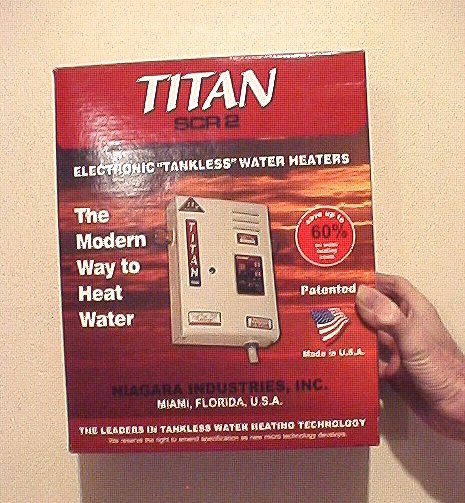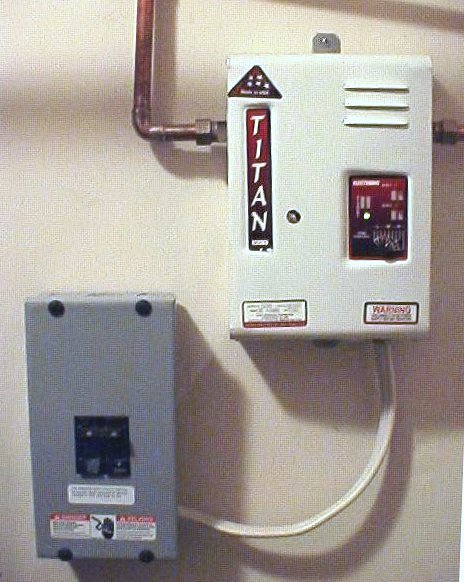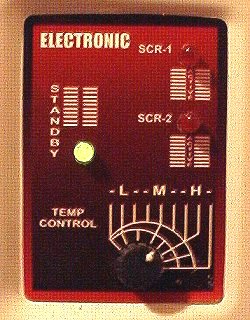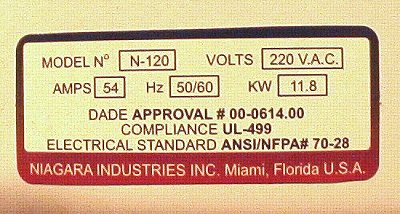My Electric Tankless Water Heater
When the local price of natural gas spiked a few years ago, I paid off my bill and told the gas company to ... no, I didn't say that, but I wanted to. I just asked them to close my account. Since my water heater ran on natural gas, it is now an ornament on my back porch. (Why yes, I live in Georgia, why do you ask?)
In
its place, and taking up much less space, is now a Titan SCR2 electronic tankless water heater, model N-120, which I acquired new from an eBay auction for about $200. |
 |
This
compact system is touted to be a "whole house" model.
 |
Installation was relatively painless since I installed it in my utility room, the same location as the old heater and happened to have an unused 220 volt line right beside it. The
220 line was installed back when I added a couple of rooms on to my house but the line never got used because my clothes dryer was gas. Now the sun dries my laundry. A
drawback of installing the heater in the utility room is the 20 foot run of pipe to reach the kitchen sink and the 45 foot run to the bathroom and shower. That
wastes a bit of power and water while waiting for the hot water to reach the outlet. Ideally,
it should have been installed between the two... or better yet, two units installed right at the points of use, but I worked with what I had. Here
you see it installed in my utility room with a 60 amp breaker box. |
 |
 |
Close-up of the temperature adjustment and indicator led's. |
Spec. Sticker |
Observations
I have made since installing the system:Coupled
with a low-flow showerhead (which I was already using anyway) this unit is quite capable of delivering a nice, warm shower. However, the adjustments of the cold and hot take some getting used to for maximum economy.
The
heater will not deliver very hot water at a high flow rate. The natural inclination when we want the shower a little hotter is to open the hot valve further, but that may well just deliver more, but cooler, water if the heater was already running at peak performance. Instead, it is better to close the cold valve a bit.
You
~could~ just crank the hot water valve all the way open with no cold mixed in. This would indeed give you a luke warm shower because the water is flowing through the heater at a rate faster than it can heat it to the preset temperature. That is a wasteful practice though. The heater would remain full-on, drawing a constant 54 amps from the grid for the duration of your shower.
I
have found that if I first turn on the hot water valve about an eighth to a quarter of a turn and wait for the hot to arrive, it will slowly increase in temperature as it warms the pipes it is travelling through until it is very hot, almost scalding even. This water will be pretty close to the temperature you preset with the dial on the front of the heater, and I can see that the heater is turning on and off by the slight flickering of my lights. That off time is energy saved!
Then
I turn on some cold to bring the pressure up and the temperature down to a comfortable level. As I shower, I find that the water temperature still slowly climbs and I occasionally add more cold for a little more pressure, or turn the hot down a bit if the pressure is adequate. By the time I am finished showering, I turn off the cold first and am continually amazed at the small volume of hot I was using. It is little more than a good trickle yet I managed to steam up the mirror!
Hmmm...
at least that's the way it works where I live, in a mild climate, where my city supplied water comes out of the pipe at about 60 degrees F. Your milage may vary depending on where you live and your circumstances. Manufacturers can't realistically tell you what temperature your water will be at any given flow rate, because it depends on the temperature of the water entering the unit. Instead, they will have a chart that shows temperature Increase vs flow rate. (If you can preheat the water somehow, it can make a big difference!)
Advantages:
1)
Purchase price of the unit. Although you can pay much more for one of these units, the eBay auctions for brand new (not refurbished) units are plentiful and most of them seem to end at about $200 USD. (Some of the sellers offer free shipping!) I priced new tank-type units and found they run about $300 to $450 in my area (40 gallon capacity).
2)
No venting required. A carbon dioxide generator has been removed from my home.
3)
No tank to rust out and leak.
4)
No tank to sit and constantly loose heat into the room. It and the vent stack were making my air conditioner work harder. Plus the vent was loosing heat from my home during the winter.
5)
Small size. It only measures 7"W x 10"H x 2-3/4"D and weighs 8 pounds, less than an M1 rifle! My utility room was crowded enough. Getting rid of that tank freed up a little space for me to pile more junk.
6)
I have no natural gas bill. At the same time I installed the Titan, I replaced all the incandescent bulbs in my house with CFL's. In the 8 months since then, my electric budget bill has actually been reduced by about $20 per month.
7)
When showering with my old tank heater installed, if someone flushed a toilet or turned on the kitchen faucet, they might get cussed at. With the tankless heater installed, this problem has gone away. I'm not quite sure why, but it has.
8) No tank to potentially go BOOM. When your thermostat or gas valve fails to shut down and your pressure relief valve is stuck closed because it is ancient, it is a proven fact that the resulting *BLEVE can ruin your whole day! *pronounced("blevvy"),
is an acronym for "boiling liquid expanding vapour explosion" |
 |
|
|
Fortunately, no one was killed. The only occupant of the house was helped out of the rubble by neighbors, but I doubt she could hear very well. |
Disadvantages:
1)
It sucks quite a lot of electricity. Rated at 54 amps maximum. That's 11.8 kilowatts! It draws enough current that my room lights flicker a bit. ~But only when you run hot water~ In standby mode, it only uses a few milliwatts.
2)
Has trouble delivering very hot water at high flow rates. Preheating water with a solar heater would probably eliminate that problem.
3)
My kitchen faucet is one of the one-handle jobs where you swing the handle to the right or left to adjust the temperature. When I turn it on even for just cold water, there is enough pressure drop in the hot line to turn the heater on. I can tell by the overhead lights flickering.
4)
I can't think of any others. I'm very pleased with the unit.
What's
next? This should be fun...
I
plan to build a solar powered water preheating system to lessen the amount of work the Titan needs to do to bring the water up to the dialed-in temperature thus saving electricity. I have yet to decide whether to use a parabolic trough or perhaps a fresnel lens setup. I have ordered 4 small 7" x 10" fresnel lenses and a 4' x 25' roll of mirror type mylar to experiment with.
Some
people find that just a very long length of black hose coiled up on their roof does a good job but it needs to be a good quality hose since it is under constant pressure and it won't work during freezing weather. If I lived in Florida, that's the route I would travel.
More
to come...
HOME

Free counters provided by Andale.
